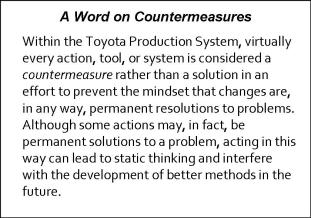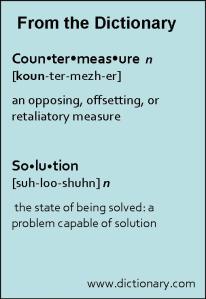One element of the Toyota Production System that has not gained much attention is the practice of addressing problems with countermeasures instead of solutions. Although seemingly nothing more than an issue of semantics, I find the focus on countermeasures versus solutions rather significant.
Solutions Thinking
One of the common misunderstandings many people have about six sigma or kaizen is the idea that the tools will lead to the development of a solution to the root cause of a problem. Organizations are highly complex systems and it is naive to think that any of the problems they face result from a single root cause or can be resolved by a single solution.
When all of the factors and interactions that can influence work are understood, it becomes clear that the best we can do is attack problems by addressing as many of the perceived causes as possible with the idea that we may never permanently fix the issue. Because of this, remaining competitive requires continually developing and implementing measures to improve processes and accept the fact that some of the problems the organization faces may never completely disappear.
This is a difficult concept for many to accept because of the importance our culture places on solving problems. Countermeasures can, at first glance, appear to be nothing more than temporary fixes to problems rather than permanent solutions – which is counter to what organizations are trying to achieve with lean. In reality though, it is just the opposite, because a solutions thinking mindset can give a false sense of security that a particular problem has, in fact, been eliminated. This can be very dangerous down the road if a problem that the team thinks it resolved returns.
This is not to say that a countermeasure approach focuses on symptoms of a problem rather than the root causes. The tools and methods associated with an effective kaizen process help a team get down to the root causes of a problem. The difference with this line of thinking, however, is the concept that there are several potential root causes to any problem and that actions taken to address a problem are based on what is known today with whatever information is currently available. As the environment changes, the problem can reappear as a result of new or different interactions that were not known at the time it was last studied. Although the initial countermeasures were valuable to the company, the team needs to continue its efforts to assure performance remains stable or continues to improve.
The Learning Organization
Another significant advantage of a countermeasure approach is the amount of learning that takes place within the team. Rather than studying the problem, developing a solution, and moving on, the team moves around the PDCA cycle many times as it continues to address root causes with more and better countermeasures. With each trip around the cycle, the team learns more about the process and the interactions where problems can occur. As a result of continuing to develop and test hypotheses, team members truly become experts about the processes with which they work.
A Cultural Transformation
One of the critical challenges of lean thinking is changing the organization’s culture so people get the idea that continual improvement is not only possible, but necessary for survival. Talking in terms of solutions, however, can actually interfere with this type of transformation.
In the most basic sense, the term countermeasure refers to action(s) taken in response to a problem, whereas a solution implies achieving a state where a problem has been eliminated. [See definitions] Note that the term countermeasure makes no reference to solving a problem.
When the team starts referring to improvements as countermeasures instead of solutions, the culture starts to change. People begin to believe that problems may never be completely solved and understand the need to continually strengthen processes. Improvements are celebrated, but only as temporary steps toward the ultimate, albeit unattainable goal of perfection.
Starting at the Top
Adopting a countermeasure mindset within the organization requires a good deal of clarity and consistency from leaders. There will be frequent opportunities to coach team members on a new way to look at and address problems. As with any type of culture shift, however, there will be a good deal of inertia pulling the team back to old – and more comfortable – ways of thinking. Because of this, it is critical that leaders apply relevant countermeasures when progress has slowed. Like mountain climbing, organizational transformation can take significant time and effort to make a small amount of progress; while any lapse in focus can result in a fairly quick decline.
Dear Mr. Stocker.
I hope this finds you well.
I am writing on behalf of the Digital Education Educator at Boston University to request permission to use your blog post entitled ” Addressing Problems With Countermeasures Rather Than Solutions” and published on April 7th, 2012 in one of our Massive Open Online course entitled “Designing for Experimentation to Enhance Digital Business Innovation” and to be distributed on the edX website at this URL: https://www.edx.org/course/designing-experimentation-enhance-bux-qd601x.
Could you please contact me at mhemono@bu.edu in order to discuss further?
Warm regards
LikeLike
Posted by Mathieu Hémono | January 18, 2018, 10:52 amHello Mathieu,
Thank you for contacting me about using my blog post in an upcoming course. Please feel free to use the post in the course but I ask that you credit the blog and my name when you distribute it. Please let me know if you need any additional information.
Regards,
Gregg Stocker
Email: gstocker@att.net
Ph: +45 3038 2654
LikeLike
Posted by Gregg Stocker | January 19, 2018, 5:25 am